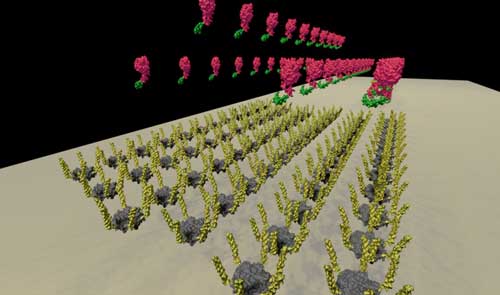| Dec 16, 2019 | |
A new tool tidies up molecules at the nano level(Nanowerk News) Tidying up. Not an idea associated with living cells on the nanoscale. But just as a mismash of IKEA bits scattered throughout your bedroom is less useful than a neatly-assembled dresser, synthetic biologists wish to have tools to organize “scattered” components inside living cells. |
|
| This simple idea is important for scientists studying how to engineer life at the cellular, and even smaller, levels. | |
| A new study from Michigan State University reports the design of new, artificial cellular parts that can organize, “tidy up,” targeted molecules inside living cells. The study is published in Nano Letters ("Visualizing in Vivo Dynamics of Designer Nanoscaffolds"). | |
| Synthetic biologists like to view living cells as a collection of biological parts that can be taken apart. One can begin to learn the rules of molecular life by studying each part. Then, once they are understood, one can tinker with them, mix and match parts to create new, never before seen functions. Think: renewable energy resources, or new ways to deliver medicines, just to name a couple applications. | |
| Eric Young, a former graduate student in the Ducat lab in the MSU-DOE Plant Research Laboratory team, works with a promising family of building blocks — known as BMC-H proteins. In nature, they help create cellular factories in bacteria to make food or isolate toxic materials. | |
| In the new study, the researchers engineered BMC-H proteins to act as homing beacons that attract molecular cargo inside a cell. | |
| “We know that some BMC-H proteins can come together to create different shapes, like tubes, sheets, and other unique assemblies,” Young said. “These shapes can act as scaffolds to host other molecules, but they can’t do it on their own. So we gave them new protein extensions, from another ‘parts’ library, and added them to the BMC-H building block.” | |
| The new designs form never-before seen nanostructures within the cells. | |
| Next, the team tested if the extensions work as homing beacons inside living cells. The ‘bait’ was a glowing test molecule, linked to another extention, and set free to travel throughout a cell. Indeed, the glowing molecules clustered in the same space as the engineered BMC-H proteins. (The glowing molecule emits light under a microscope, which provides visual proof the concept works.) | |
 |
|
| BMC-H proteins (grey) with added extensions (yellow) form scaffolds and act as homing beacons to attract the glowing molecules (pink). (Image: MSU) | |
| “We eventually found we could delay production of the scaffold, then turn the ‘on’ switch, and simply watch the ‘bait’ move in response,” Young said. “We really got creative in imaging the process. It still amazes me to watch how the organization of molecules begins to change, due to our influence.” | |
| Now they have figured out the ‘tidying up’ part, the team wants to learn more about the system and develop new parts. | |
| “The molecular dream is to be able to build whatever we want on the nano-scale,” Young said. “Just like we can organize resources at the macro-scale, we could use different scientific approaches to engineer nano-sized structures for specific applications.” | |
| “For example, we could use these parts to create little landing pads to cluster resources and speed up the production of medical or industrial compounds,” Young said. | |
| Young also wants to share the tool with like-minded scientists. He thinks it could be a useful educational and production toolkit. | |
| “It can be relatively easy to learn and fun to use. I hope it can inspire the next generation of scientists and engineers to see, with their own eyes, how one can shape matter at the nanoscale,” Young said. |
| Source: Michigan State University | |
|
Subscribe to a free copy of one of our daily Nanowerk Newsletter Email Digests with a compilation of all of the day's news. |
